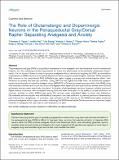The Role of Glutamatergic and Dopaminergic Neurons in the Periaqueductal Gray/Dorsal Raphe: Separating Analgesia and Anxiety
Author(s)
Taylor, Norman E.; Pei, JunZhu; Zhang, Jie; Vlasov, Ksenia; Davis, Trevor; Taylor, Emma; Weng, Feng-Ju; Van Dort, Christa J.; Solt, Ken; Brown, Emery Neal; ... Show more Show less
DownloadPublished version (2.668Mb)
Terms of use
Metadata
Show full item recordAbstract
The periaqueductal gray (PAG) is a significant modulator of both analgesic and fear behaviors in both humans and rodents, but the underlying circuitry responsible for these two phenotypes is incompletely understood. Importantly, it is not known if there is a way to produce analgesia without anxiety by targeting the PAG, as modulation of glutamate or GABA neurons in this area initiates both antinociceptive and anxiogenic behavior. While dopamine (DA) neurons in the ventrolateral PAG (vlPAG)/dorsal raphe display a supraspinal antinociceptive effect, their influence on anxiety and fear are unknown. Using DAT-cre and Vglut2-cre male mice, we introduced designer receptors exclusively activated by designer drugs (DREADD) to DA and glutamate neurons within the vlPAG using viral-mediated delivery and found that levels of analgesia were significant and quantitatively similar when DA and glutamate neurons were selectively stimulated. Activation of glutamatergic neurons, however, reliably produced higher indices of anxiety, with increased freezing time and more time spent in the safety of a dark enclosure. In contrast, animals in which PAG/dorsal raphe DA neurons were stimulated failed to show fear behaviors. DA-mediated antinociception was inhibitable by haloperidol and was sufficient to prevent persistent inflammatory pain induced by carrageenan. In summary, only activation of DA neurons in the PAG/dorsal raphe produced profound analgesia without signs of anxiety, indicating that PAG/dorsal raphe DA neurons are an important target involved in analgesia that may lead to new treatments for pain.
Date issued
2019-01Department
Picower Institute for Learning and Memory; Massachusetts Institute of Technology. Department of Brain and Cognitive SciencesJournal
eNeuro
Publisher
Society for Neuroscience
Citation
Taylor, Norman E. "The Role of Glutamatergic and Dopaminergic Neurons in the Periaqueductal Gray/Dorsal Raphe: Separating Analgesia and Anxiety." eNeuro 6, 1 (January 2019): e0018-18.2019 © 2019 Taylor et al
Version: Final published version
ISSN
2373-2822